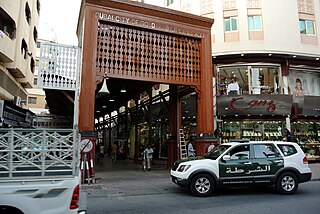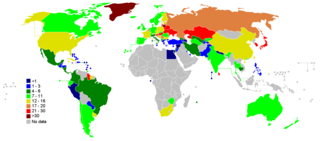Child sex tourism (CST) is tourism for the purpose of engaging in the prostitution of children, which is commercially facilitated child sexual abuse. The definition of child in the United Nations Convention on the Rights of the Child is "every human being below the age of 18 years". Child sex tourism results in both mental and physical consequences for the exploited children, which may include sexually transmitted infections, "drug addiction, pregnancy, malnutrition, social ostracism, and death", according to the State Department of the United States. Child sex tourism, part of the multibillion-dollar global sex tourism industry, is a form of child prostitution within the wider issue of commercial sexual exploitation of children. Child sex tourism victimizes approximately 2 million children around the world. The children who perform as prostitutes in the child sex tourism trade often have been lured or abducted into sexual slavery.
Dowry deaths are deaths of married women who are murdered or driven to suicide over disputes about dowry. Dowry deaths are found predominantly in India, Pakistan, Bangladesh, and Iran.

The National Crime Records Bureau (NCRB) is an Indian government agency responsible for collecting and analyzing ,crime data as defined by the Indian Penal Code (IPC) and Special and Local Laws (SLL). NCRB is headquartered in New Delhi and is part of the Ministry of Home Affairs (MHA), Government of India. Ramphal Pawar (IPS) is current Director of National Crime Record Bureau.
The Scheduled Castes and the Scheduled Tribes Act, 1989 was enacted by the Parliament of India to prevent atrocities and hate crimes against the scheduled castes and scheduled tribes. The Act is popularly known as the SC/ST Act, PoA, or simply the 'Atrocities Act'.
Crime in India has been recorded since the British Raj, with comprehensive statistics now compiled annually by the National Crime Records Bureau (NCRB), under the Ministry of Home Affairs (India) (MHA).

Ratua I is a community development block that forms an administrative division in Chanchal subdivision of Malda district in the Indian state of West Bengal.

The crime rate in the United Arab Emirates is relatively low compared to more highly industrialized nations. Incidents of petty crime such as pickpocketing are low. The United States Department of State states: "Crime generally is not a problem for travelers in the UAE. However, the U.S. Embassy advises U.S. citizens to take normal precautions against theft, such as not leaving a wallet, purse, or credit card unattended. Although vehicle break-ins in the UAE are rare, U.S. citizens are encouraged to ensure that unattended vehicles are locked and that valuables are not left out in plain sight".
Human trafficking in India, although illegal under Indian law, remains a significant problem. People are frequently illegally trafficked through India for the purposes of commercial sexual exploitation and forced/bonded labour. Although no reliable study of forced and bonded labour has been completed, NGOs estimate this problem affects 20 to 65 million Indians. Men, women and children are trafficked in India for diverse reasons. Women and girls are trafficked within the country for the purposes of commercial sexual exploitation and forced marriage, especially in those areas where the sex ratio is highly skewed in favour of men. Men and boys are trafficked for the purposes of labour, and may be sexually exploited by traffickers to serve as gigolos, massage experts, escorts, etc. A significant portion of children are subjected to forced labour as factory workers, domestic servants, beggars, and agriculture workers, and have been used as armed combatants by some terrorist and insurgent groups.

In the United States, human trafficking tends to occur around international travel hubs with large immigrant populations, notably in California, Texas, and Georgia. Those trafficked include young children, teenagers, men, and women; victims can be domestic citizens or foreign nationals.

India has a very high volume of child trafficking. As many as one child disappears every eight minutes, according to the National Crime Records Bureau. In some cases, children are taken from their homes to be bought and sold in the market. In other cases, children are tricked into the hands of traffickers by being presented an opportunity for a job, when in reality, upon arrival they become enslaved. In India, there are many children trafficked for various reasons such as labor, begging, and sexual exploitation. Because of the nature of this crime; it is hard to track; and due to the poor enforcement of laws, it is difficult to prevent. Due to the nature of this crime, it is only possible to have estimates of figures regarding the issue. India is a prime area for child trafficking to occur, as many of those trafficked are from, travel through or destined to go to India. Though most of the trafficking occurs within the country, there is also a significant number of children trafficked from Nepal and Bangladesh. There are many different causes that lead to child trafficking, with the primary reasons being poverty, weak law enforcement, and a lack of good quality public education. The traffickers that take advantage of children can be from another area in India, or could even know the child personally. Children who return home after being trafficked often face shame in their communities, rather than being welcomed home.

About 800,000 people die by suicide worldwide every year. 164,033 Indians committed suicide in 2021 and the national suicide rate was 12, which is the highest rate of deaths from suicides since 1967, which is the earliest recorded year for this data. According to The World Health Organization, in India, suicide is an emerging and serious public health issue.

Bamangola is a community development block that forms an administrative division in Malda Sadar subdivision of Malda district in the Indian state of West Bengal.
Rape is the fourth most common crime against women in India. According to the 2021 annual report of the National Crime Records Bureau (NCRB), 31,677 rape cases were registered across the country, or an average of 86 cases daily, a rise from 2020 with 28,046 cases, while in 2019, 32,033 cases were registered. Of the total 31,677 rape cases, 28,147(nearly 89%) of the rapes were committed by persons known to the victim. The share of victims who were minors or below 18 - the legal age of consent - stood at 10%.
Prisons, and their administration, is a state subject covered by item 4 under the State List in the Seventh Schedule of the Constitution of India. The management and administration of prisons falls exclusively in the domain of the State governments, and is governed by the Prisons Act, 1894 and the Prison manuals of the respective state governments. Thus, the states have the primary role, responsibility and authority to change the current prison laws, rules and regulations. The Central Government provides assistance to the states to improve security in prisons, for the repair and renovation of old prisons, medical facilities, development of borstal schools, facilities to women offenders, vocational training, modernization of prison industries, training to prison personnel, and for the creation of high security enclosures.
Violence against women in Tamil Nadu includes molestation, abduction, dowry-related violence, and domestic violence. The police recorded 1,130 cases during the first seven months in 2013, compared to 860 for the corresponding period in 2012. In Usilampatti Taluk, around 6,000 female children were killed in a span of 2 years during 1987–88, accounting to the single largest instance of recorded female infanticide.

Violence against women in India refers to physical or sexual violence committed against a woman, typically by a man. Common forms of violence against women in India include acts such as domestic abuse, sexual assault, and murder. In order to be considered violence against women, the act must be committed solely because the victim is female. Most typically, these acts are committed by men as a result of the long-standing gender inequalities present in the country.
This is a list of states and union territories of India ranked according to crime against women and rate of crime against women. The list is compiled from the 2016 and 2018 Crime in India Report published by National Crime Records Bureau (NCRB), Government of India.
Human rights in Trinidad and Tobago comprise a series of rights legally protected by the Constitution of Trinidad and Tobago. Trinidad and Tobago has ratified a number of international treaties and conventions on human rights and parts or principles of these legal texts have been integrated into the domestic laws of the country. The Ministry of the Attorney General has established the International Law and Human Rights Unit to ensure adherence to these principles.







